Elisa Rolle's Blog, page 322
January 12, 2016
Queer Places: Plas Newydd, Llangollen
Address: Plas Newydd, Hill Street, Llangollen LL20 8AW, UK
Plas Newydd is a historic house in the town of Llangollen, Denbighshire, Wales, and was the home of the Ladies of Llangollen, Lady Eleanor Butler and Sarah Ponsonby, for nearly 50 years. Today, it is run as a museum by Denbighshire County Council.
The original cottage was expanded by the Ladies, and then again by subsequent owners in the 19th century. It is now returned to essentially the final structure left by the Ladies. Its most unusual feature is the profusion of pieces of reclaimed oak carvings collected by the Ladies and set in patchwork style over much of the wall areas of the house. These came from broken-up furniture or church fittings and range in date from the medieval to the Baroque, but with folk and "Jacobean" vernacular styles of shallow carved decoration predominating.
The house appeared in the 1989 BBC adaptation of The Voyage of the Dawn Treader (one of the Narnia Chronicles written by C.S. Lewis) as the home of the wizard Coriakin (played by Preston Lockwood).

It was also used in a 1987 episode of the TV series Treasure Hunt and Antiques Road Trip in 2013. It was also featured on Most Haunted.
The Ladies of Llangollen were two upper-class women from Ireland whose relationship scandalised and fascinated their contemporaries.
Eleanor Charlotte Butler (11 May 1739 – 2 June 1829) was a member of one of the dynastic families of Ireland, the Butlers, the Earls (and later Dukes) of Ormond. Eleanor was considered an over-educated bookworm by her family, who resided at the Butler family seat Kilkenny Castle. She spoke French and was educated in a convent in France. Her mother tried to make her join a convent because she was remaining a spinster.
Sarah Ponsonby (1755–9 December 1831) lived with relatives in Woodstock, County Kilkenny, Ireland. She was a second cousin of Frederick Ponsonby, 3rd Earl of Bessborough, and thus a second cousin once-removed, of his daughter the Lady Caroline Lamb.
Their families lived only two miles (3 km) from each other. They met in 1768, and quickly became friends. Over the years they formulated a plan for a private rural retreat.
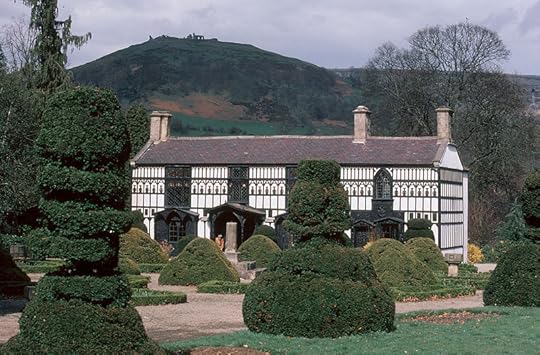
Rather than face the possibility of being forced into unwanted marriages, they left County Kilkenny together in April 1778. Their families hunted them down and forcefully tried to make them give up their plans – in vain.
After a couple of years, their life attracted the interest of the outside world. Their house became a haven for visitors, mostly writers such as Robert Southey, William Wordsworth, Percy Shelley, Lord Byron and Sir Walter Scott, but also the military leader the Duke of Wellington and the industrialist Josiah Wedgwood; aristocratic novelist Caroline Lamb, who was born a Ponsonby, came to visit too. Even travellers from continental Europe had heard of the couple and came to visit them, for instance Prince Hermann von Pückler-Muskau, the German nobleman and landscape designer, who wrote admiringly about them.
The ladies were known throughout Britain, but have been said to have led "a rather unexciting life". Queen Charlotte wanted to see their cottage and persuaded the King to grant them a pension.
Butler and Ponsonby lived together for the rest of their lives, over 50 years. Their books and glassware had both sets of initials and their letters were jointly signed.
Eleanor Butler died in 1829. Sarah Ponsonby died two years later. They are both buried at St Collen's church in Llangollen.
 comments
comments
Plas Newydd is a historic house in the town of Llangollen, Denbighshire, Wales, and was the home of the Ladies of Llangollen, Lady Eleanor Butler and Sarah Ponsonby, for nearly 50 years. Today, it is run as a museum by Denbighshire County Council.
The original cottage was expanded by the Ladies, and then again by subsequent owners in the 19th century. It is now returned to essentially the final structure left by the Ladies. Its most unusual feature is the profusion of pieces of reclaimed oak carvings collected by the Ladies and set in patchwork style over much of the wall areas of the house. These came from broken-up furniture or church fittings and range in date from the medieval to the Baroque, but with folk and "Jacobean" vernacular styles of shallow carved decoration predominating.
The house appeared in the 1989 BBC adaptation of The Voyage of the Dawn Treader (one of the Narnia Chronicles written by C.S. Lewis) as the home of the wizard Coriakin (played by Preston Lockwood).

It was also used in a 1987 episode of the TV series Treasure Hunt and Antiques Road Trip in 2013. It was also featured on Most Haunted.
The Ladies of Llangollen were two upper-class women from Ireland whose relationship scandalised and fascinated their contemporaries.
Eleanor Charlotte Butler (11 May 1739 – 2 June 1829) was a member of one of the dynastic families of Ireland, the Butlers, the Earls (and later Dukes) of Ormond. Eleanor was considered an over-educated bookworm by her family, who resided at the Butler family seat Kilkenny Castle. She spoke French and was educated in a convent in France. Her mother tried to make her join a convent because she was remaining a spinster.
Sarah Ponsonby (1755–9 December 1831) lived with relatives in Woodstock, County Kilkenny, Ireland. She was a second cousin of Frederick Ponsonby, 3rd Earl of Bessborough, and thus a second cousin once-removed, of his daughter the Lady Caroline Lamb.
Their families lived only two miles (3 km) from each other. They met in 1768, and quickly became friends. Over the years they formulated a plan for a private rural retreat.

Rather than face the possibility of being forced into unwanted marriages, they left County Kilkenny together in April 1778. Their families hunted them down and forcefully tried to make them give up their plans – in vain.
After a couple of years, their life attracted the interest of the outside world. Their house became a haven for visitors, mostly writers such as Robert Southey, William Wordsworth, Percy Shelley, Lord Byron and Sir Walter Scott, but also the military leader the Duke of Wellington and the industrialist Josiah Wedgwood; aristocratic novelist Caroline Lamb, who was born a Ponsonby, came to visit too. Even travellers from continental Europe had heard of the couple and came to visit them, for instance Prince Hermann von Pückler-Muskau, the German nobleman and landscape designer, who wrote admiringly about them.
The ladies were known throughout Britain, but have been said to have led "a rather unexciting life". Queen Charlotte wanted to see their cottage and persuaded the King to grant them a pension.
Butler and Ponsonby lived together for the rest of their lives, over 50 years. Their books and glassware had both sets of initials and their letters were jointly signed.
Eleanor Butler died in 1829. Sarah Ponsonby died two years later. They are both buried at St Collen's church in Llangollen.
 comments
comments
Published on January 12, 2016 10:06
Blog Tour: Fall From Grace by Adrian J. Smith
 For By Grace, Fallen From Grace, Grace Through Redemption (Spirit of Grace 1, 2 and 3) by Adrian J. Smith
For By Grace, Fallen From Grace, Grace Through Redemption (Spirit of Grace 1, 2 and 3) by Adrian J. SmithBlurb(s):
For by Grace
Paperback: 254 pages
Publisher: Supposed Crimes, LLC (October 1, 2015)
Language: English
ISBN-10: 1938108833
ISBN-13: 978-1938108839
Amazon: For by Grace
Amazon Kindle: For by Grace
Being a Sheriff’s Deputy is not all about saving lives and arresting criminals, and each day Grace wonders if she’ll make it home.
While kids at the schools Deputy Grace Halling visits see her as the knight in blue-cotton armor, people involved in the cases she is dispatched to have a different opinion. She has every confidence in her ability to do her job and arrest criminals. She easily takes down a knife-wielding woman and a drunken combatant teenager without hesitation. Everyone—victim, suspect, or witness—has a story to tell or to lie about, and Grace is never perturbed by their tales.
That all changes when she looks down the barrel of a gun. She loses confidence in her ability as a deputy, she loses trust in herself and fellow officers, and she struggles to stay afloat as shift after shift passes. Grace cannot find her rhythm of being a deputy again. And when the Police Chaplain unexpectedly barges into her life, her personal and professional lives are flipped upside down. Grace struggles to find her even ground, worrying that the next time she stares a murderer in the face will be the last.
 Fallen from Grace
Fallen from GracePublisher: Supposed Crimes LLC; 1 edition (June 1, 2015)
Amazon Kindle: Fallen from Grace
Parables and riddles can’t undo the confusion Deputy Grace Halling experiences after her close call with death. Each morning she wakes up, puts on a uniform that feels far more like a target, and goes out to enforce the laws and protect the innocent. While her comrades in blue are murdered one by one with each passing month, Grace pushes for a call to action from her Captain. Her worst fear has become a reality.
Grace doesn’t know if she’s next.
 Grace through Redemption
Grace through RedemptionPaperback: 252 pages
Publisher: Supposed Crimes, LLC (December 1, 2015)
Language: English
ISBN-10: 1938108736
ISBN-13: 978-1938108730
Amazon: Grace through Redemption
Amazon Kindle: Grace through Redemption
Learning to trust herself again wasn’t easy. Deputy Grace Halling is back patrolling, and after a few months of quiet, murders of her comrades in blue begin again. Scared and determined, Grace follows every lead she can until she finds herself face to face with the barrel of a gun, only this time her finger is on the trigger.
( Excerpt: (From Grace Through Redemption) )

 Meet the author: Adrian J. Smith, or "AJ" as she is often called, is a part time writer with an epic imagination, sharp wit, and kind heart that gets her into a bit of trouble when it comes to taking in all the neighborhood stray cats. Being obsessed with science fiction, Smith often goes off on tangents about the space-time continuum. She is also a part time lunatic with a secretive past. It's been rumored that she was once a spy for the government, but anyone who has gotten close enough to know the truth has never lived to tell the tale. When traveling around the world on various classified tasks, Smith requires the following be provided: buffalo jerky, mimosas, and eighty six pennies. This is all we know about the reclusive woman.
Meet the author: Adrian J. Smith, or "AJ" as she is often called, is a part time writer with an epic imagination, sharp wit, and kind heart that gets her into a bit of trouble when it comes to taking in all the neighborhood stray cats. Being obsessed with science fiction, Smith often goes off on tangents about the space-time continuum. She is also a part time lunatic with a secretive past. It's been rumored that she was once a spy for the government, but anyone who has gotten close enough to know the truth has never lived to tell the tale. When traveling around the world on various classified tasks, Smith requires the following be provided: buffalo jerky, mimosas, and eighty six pennies. This is all we know about the reclusive woman.Someone asks you for advice about writing. What do you tell them?
I actually get this question a lot, or I get people messaging me on FB asking for a pep talk (that happened this morning). My advice is to always keep writing. If you enjoy it, then keep writing. There’s no reason to stress about publishing, editing, covers, all that fun unless you intend on publishing. But if you lose the joy in writing itself, then there’s no reason to continue.
Writing, the process of creating, has to be first and foremost the joy we get out of what happens. If that goes away, then we have nothing left. So keep writing, because writing is what drives us. Without it there is nothing else.
Where to find the author:
Facebook: www.facebook.com/adrian.j.smith066
Facebook: www.facebook.com/adrianjsmithbooks
Facebook: www.facebook.com/supposedcrimes
Twitter: @AdrianAJSmith
Goodreads Links:
For by Grace: http://bit.ly/1iI9D3w
Fallen from Grace: http://bit.ly/1GQ5pxo
Grace through Redemption: http://bit.ly/1S3U9TB

( Tour Dates & Stops: )
Giveaway:
Rafflecopter Prize: 2 Signed copies of For by Grace and Grace Through Redemption
Rafflecopter Code:
a Rafflecopter giveaway

 comments
comments
Published on January 12, 2016 09:58
January 11, 2016
Queer Places: Wanstead Park
Address: Wanstead Park, London, UK
Wanstead Park is a grade II listed municipal park covering an area of about 140 acres (57 hectares), located in Wanstead, in the London Borough of Redbridge, historically within the county of Essex. It is bordered to the north by the A12 road, to the east by the River Roding and A406 North Circular Road, to the south by the Aldersbrook Estate and the City of London Cemetery and Crematorium and to the west by Wanstead Golf Course. It is administered as part of Epping Forest by the City of London Corporation, having been purchased by the Corporation in 1880. Today's park once formed part of the deer park of the former manor house of ancient Wanstead Manor, which included much of the urbanised area now known as Wanstead.
Ordinance Survey maps mark the site of a Roman Villa in present day Wanstead Park. The name Wanstead is probably of Saxon origin - indicating a possible continuity of settlement here since Roman times - and is accepted by the English Place-Names Society as derived from Wen, signifying a hill or mound, and Stead, a place. It is said that in Saxon times Abbot Aelfric granted the manor of Wanstead to the monks of Westminster Abbey yet this cannot be substantiated from any documentary evidence. However, the location was clearly a prized site on the east side of London.
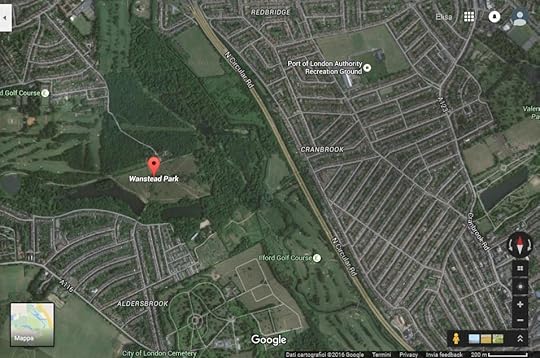
In 1086 the Domesday Book states that Wanstead Manor was held from the Bishop of London by one Ralph son of Brian. Wanstead was then densely wooded, being situated within the Forest of Essex. It was part of the forest bailiwick of Becontree during the Middle Ages and later of the Leyton "Walk".
The manor house, known as Wanstead Hall, was probably quite a small building until the 14th century, but by 1499 it was large enough to serve as a royal hunting-lodge, when it was acquired by King Henry VII, and it was to become one of whose favourite resorts. Lord Richard Rich, High Chancellor of England, was keeper of the park in 1543, and in 1549 Edward VI granted him the lordship of the manor of Wanstead, complete with the park. In 1577 Rich's son Robert sold it to Robert Dudley, 1st Earl of Leicester, who purchased the nearby manor of Stonhall in Ilford at the same time. Thereafter a succession of owners kept the manor of Wanstead combined with Stonehall.
In 1619 Sir Henry Mildmay was in possession, but forfeited the manor to the Crown at the end of the Civil War, in which he had fought for Parliament. Charles II granted the estate to his brother, James, Duke of York, but it was restored in about 1662 to Sir Robert Brooke, Mildmay's son in law. In 1673-4 the manor was purchased by Josiah Child (created 1st Baronet Child of Wanstead in 1678)' Governor of the East India Company. Child died in 1699, and was succeeded by his son - also Sir Josiah Child - who leased Wanstead and Stonehall to his half-brother, Richard Child. On Sir Josiah II's death in 1704, Richard Child became 3rd Baronet, having succeeded to his title and estates.
In 1715 Sir Richard Child commissioned the Scottish architect Colen Campbell to design a grand mansion in the then emerging Palladian style, to replace the former house, and to rival contemporary mansions such as Blenheim Palace. The grounds were landscaped and planted with formal avenues of trees by George London, one of the leading garden designers of his day. Child was created 1st Viscount Castlemaine 3 years later in 1718, the house being completed in 1722. Child had married in 1703 Dorothy Glynne, whose mother was of the Tylney family of Tylney Hall in Rotherwick, Hampshire. On the death of Ann Tylney, her cousin, in 1730, Dorothy and her husband Viscount Castlemain inherited the Tylney estates. Castlemain was created 1st Earl Tylney the following year (1731) and in 1734 obtained an Act of Parliament to change the name of his family, including his heirs, from the patronymic to Tylney, probably to meet a condition of his wife's inheritance.

Wanstead House, by Richard Westall (1765-1836). Yale Center for British
On the death of the Earl in 1750 he was succeeded by his 38-year-old son John Tylney, 2nd Earl Tylney, who continued the plantings, but in the then fashionable natural and non-formal style. He was often associated with Horace Mann, who as well never married. The 2nd. Earl had no male issue and his estates passed on his death in 1784 to his elder sister Emma's son Sir James Long, 7th Baronet, who being then in possession of the vast estates of the Longs, the Childs and the Tylneys, assumed the surname Tylney-Long for himself and his descendants, again probably in accordance with a requirement of the inheritance. On the death of the 7th Baronet in 1794 the combined estate passed to his one-year-old infant son Sir James Tylney-Long, 8th Baronet, who died in 1805 aged just 11. The estate then passed to his young sister, eldest of three, Catherine Tylney-Long, who thereby became the richest heiress in England.
In 1812 Catherine took the disastrous step of accepting the marriage proposal from the later-to-be notorious rake, William Wellesley-Pole, nephew of two famous uncles, Richard Wellesley, 2nd Earl of Mornington, eldest brother of his father William, and Arthur Wellesley, Duke of Wellington from 1813, his father's younger brother. The Wellesleys played no part in securing the marriage into their family of this great heiress. Shortly before the wedding Catherine's husband had changed his family surname by Royal Licence to Pole-Tylney-Long-Wellesley. In 1813 Wellesley started his career of burdening the marriage settlement trust with debt by inviting the landscaper Humphrey Repton to improve the park, some of whose informal planting remains today.
Wellesley was an MP initially from 1812-20 but was principally known for his dissipation and extravagance. On his marriage the estate had been conveyed to a trust from which Catherine would receive £11,000 per annum for life, with the rest to the use of Wellesley for his life. The remainder was to go to the sons produced from the marriage. To secure a debt of £250,000, he managed to mortgage this marriage settlement trust, which owned Wanstead House and contents, to his creditors. In 1822, to escape his creditors, he obtained the office of Usher to George IV (himself experienced in profligacy and evading creditors) which rendered him immune to arrest for debt, and later he fled his creditors abroad. In June 1822 the trustees of the settlement, under a power contained within the trust and having obtained the requisite agreement of the couple, auctioned off the house's contents in an auction lasting 32 days, in order to pay off the incumbrances on the settled estate, thereby protecting the son's future inheritance. In 1825, having found no one to rent Wanstead House, the trustees demolished it under the same powers and applied the proceeds from the sale of the resultant building materials in a similar fashion. Under the terms of Sir James Tylney Long's will, Wanstead House was inalienable from the Park - which could not be sold for 1000 years. This is why the mansion was sold for demolition. The sum raised was only £10,000 whilst it had reputedly cost around £360,000 to build. Catherine, having been abandoned for another woman by her husband in 1823, died in 1825 of an intestinal illness, shortly after the demolition, no doubt a broken woman.
( Tylney Genealogy )
https://www.google.com/maps/d/edit?mid=zdRJwtySDT14.k4ln0xmbkVNk&usp=sharing
 comments
comments
Wanstead Park is a grade II listed municipal park covering an area of about 140 acres (57 hectares), located in Wanstead, in the London Borough of Redbridge, historically within the county of Essex. It is bordered to the north by the A12 road, to the east by the River Roding and A406 North Circular Road, to the south by the Aldersbrook Estate and the City of London Cemetery and Crematorium and to the west by Wanstead Golf Course. It is administered as part of Epping Forest by the City of London Corporation, having been purchased by the Corporation in 1880. Today's park once formed part of the deer park of the former manor house of ancient Wanstead Manor, which included much of the urbanised area now known as Wanstead.
Ordinance Survey maps mark the site of a Roman Villa in present day Wanstead Park. The name Wanstead is probably of Saxon origin - indicating a possible continuity of settlement here since Roman times - and is accepted by the English Place-Names Society as derived from Wen, signifying a hill or mound, and Stead, a place. It is said that in Saxon times Abbot Aelfric granted the manor of Wanstead to the monks of Westminster Abbey yet this cannot be substantiated from any documentary evidence. However, the location was clearly a prized site on the east side of London.

In 1086 the Domesday Book states that Wanstead Manor was held from the Bishop of London by one Ralph son of Brian. Wanstead was then densely wooded, being situated within the Forest of Essex. It was part of the forest bailiwick of Becontree during the Middle Ages and later of the Leyton "Walk".
The manor house, known as Wanstead Hall, was probably quite a small building until the 14th century, but by 1499 it was large enough to serve as a royal hunting-lodge, when it was acquired by King Henry VII, and it was to become one of whose favourite resorts. Lord Richard Rich, High Chancellor of England, was keeper of the park in 1543, and in 1549 Edward VI granted him the lordship of the manor of Wanstead, complete with the park. In 1577 Rich's son Robert sold it to Robert Dudley, 1st Earl of Leicester, who purchased the nearby manor of Stonhall in Ilford at the same time. Thereafter a succession of owners kept the manor of Wanstead combined with Stonehall.
In 1619 Sir Henry Mildmay was in possession, but forfeited the manor to the Crown at the end of the Civil War, in which he had fought for Parliament. Charles II granted the estate to his brother, James, Duke of York, but it was restored in about 1662 to Sir Robert Brooke, Mildmay's son in law. In 1673-4 the manor was purchased by Josiah Child (created 1st Baronet Child of Wanstead in 1678)' Governor of the East India Company. Child died in 1699, and was succeeded by his son - also Sir Josiah Child - who leased Wanstead and Stonehall to his half-brother, Richard Child. On Sir Josiah II's death in 1704, Richard Child became 3rd Baronet, having succeeded to his title and estates.
In 1715 Sir Richard Child commissioned the Scottish architect Colen Campbell to design a grand mansion in the then emerging Palladian style, to replace the former house, and to rival contemporary mansions such as Blenheim Palace. The grounds were landscaped and planted with formal avenues of trees by George London, one of the leading garden designers of his day. Child was created 1st Viscount Castlemaine 3 years later in 1718, the house being completed in 1722. Child had married in 1703 Dorothy Glynne, whose mother was of the Tylney family of Tylney Hall in Rotherwick, Hampshire. On the death of Ann Tylney, her cousin, in 1730, Dorothy and her husband Viscount Castlemain inherited the Tylney estates. Castlemain was created 1st Earl Tylney the following year (1731) and in 1734 obtained an Act of Parliament to change the name of his family, including his heirs, from the patronymic to Tylney, probably to meet a condition of his wife's inheritance.

Wanstead House, by Richard Westall (1765-1836). Yale Center for British
On the death of the Earl in 1750 he was succeeded by his 38-year-old son John Tylney, 2nd Earl Tylney, who continued the plantings, but in the then fashionable natural and non-formal style. He was often associated with Horace Mann, who as well never married. The 2nd. Earl had no male issue and his estates passed on his death in 1784 to his elder sister Emma's son Sir James Long, 7th Baronet, who being then in possession of the vast estates of the Longs, the Childs and the Tylneys, assumed the surname Tylney-Long for himself and his descendants, again probably in accordance with a requirement of the inheritance. On the death of the 7th Baronet in 1794 the combined estate passed to his one-year-old infant son Sir James Tylney-Long, 8th Baronet, who died in 1805 aged just 11. The estate then passed to his young sister, eldest of three, Catherine Tylney-Long, who thereby became the richest heiress in England.
In 1812 Catherine took the disastrous step of accepting the marriage proposal from the later-to-be notorious rake, William Wellesley-Pole, nephew of two famous uncles, Richard Wellesley, 2nd Earl of Mornington, eldest brother of his father William, and Arthur Wellesley, Duke of Wellington from 1813, his father's younger brother. The Wellesleys played no part in securing the marriage into their family of this great heiress. Shortly before the wedding Catherine's husband had changed his family surname by Royal Licence to Pole-Tylney-Long-Wellesley. In 1813 Wellesley started his career of burdening the marriage settlement trust with debt by inviting the landscaper Humphrey Repton to improve the park, some of whose informal planting remains today.
Wellesley was an MP initially from 1812-20 but was principally known for his dissipation and extravagance. On his marriage the estate had been conveyed to a trust from which Catherine would receive £11,000 per annum for life, with the rest to the use of Wellesley for his life. The remainder was to go to the sons produced from the marriage. To secure a debt of £250,000, he managed to mortgage this marriage settlement trust, which owned Wanstead House and contents, to his creditors. In 1822, to escape his creditors, he obtained the office of Usher to George IV (himself experienced in profligacy and evading creditors) which rendered him immune to arrest for debt, and later he fled his creditors abroad. In June 1822 the trustees of the settlement, under a power contained within the trust and having obtained the requisite agreement of the couple, auctioned off the house's contents in an auction lasting 32 days, in order to pay off the incumbrances on the settled estate, thereby protecting the son's future inheritance. In 1825, having found no one to rent Wanstead House, the trustees demolished it under the same powers and applied the proceeds from the sale of the resultant building materials in a similar fashion. Under the terms of Sir James Tylney Long's will, Wanstead House was inalienable from the Park - which could not be sold for 1000 years. This is why the mansion was sold for demolition. The sum raised was only £10,000 whilst it had reputedly cost around £360,000 to build. Catherine, having been abandoned for another woman by her husband in 1823, died in 1825 of an intestinal illness, shortly after the demolition, no doubt a broken woman.
( Tylney Genealogy )
https://www.google.com/maps/d/edit?mid=zdRJwtySDT14.k4ln0xmbkVNk&usp=sharing
 comments
comments
Published on January 11, 2016 06:52
January 10, 2016
Queer Places: Linton Park
Address: Linton Park
Linton
Maidstone, Kent ME17
Regno Unito
Linton Park, formerly Linton Place or Linton Hall, is a large 18th-century country house in Linton, Kent, England. Built by Robert Mann in 1730 to replace an earlier building, the house and estate passed through the ownership of several members of Mann's family before coming into the Cornwallis family. The house was enlarged to its current size in 1825.
The house sits in a prominent location, part way down a south-facing slope which provides excellent views of the grounds and the Weald beyond. Gardens close to the house contain formal walks laid out in 1825 with specimen trees planted then and later.
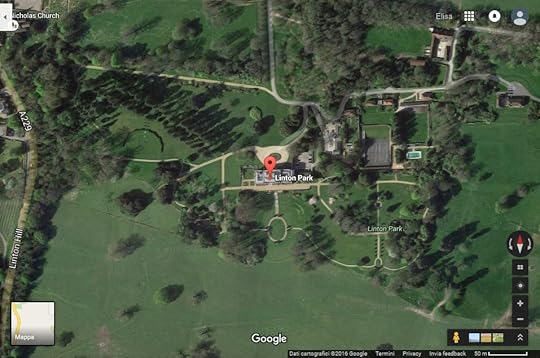
The house is a Grade I listed building and the garden and park is listed Grade II*. Other buildings and structures in the park are also listed.
Linton Park is now the corporate headquarters of Camellia plc, an international agricultural company.
Sir Horace (Horatio) Mann, 1st Baronet KB (c.25 August 1706 - 6 November 1786), diplomat, was a long standing British resident in Florence. He was the second son of Robert Mann (1678–1751), a successful London merchant, and his wife. He was brought up at Chelsea, and educated at Eton College and later, briefly, at Clare College, Cambridge.
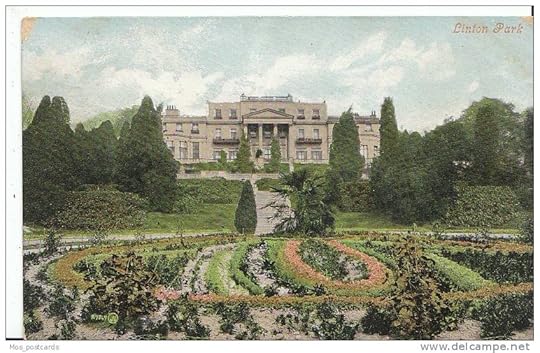
He kept an open house for British visitors at Florence, inviting them for conversazione when there was no performance at the theatre. His generosity and kindness was universally acknowledged, although his close friendship with the painter Thomas Patch (expelled from Rome after a homosexual incident) and with the effete John, 2nd Earl Tylney, reflected on his reputation. He met Horace Walpole (to whom he was distantly related, Mann's great-great-grandmother was the sister of an ancestress of Walpole) in 1739, and conducted a now-renowned correspondence with him over forty years, though they last met in 1741. The correspondence was published by Lord Dover in 1833.
William, 2nd Earl Fitzwilliam wrote that: “Sir Horace is the most finical man in the world: if you speak a little loud, he can’t bear it, it hurts his nerves, he dies – and he vomits If you eat your petite pate before your soup: take him as he is, without least notice, he is perfect character for the stage. He has been so long out of England, that he had lost the manliness of an Englishman, and has borrowed the effeminacy of Italy. But with all his little airs, he is a good kind of man, and is very civil.”
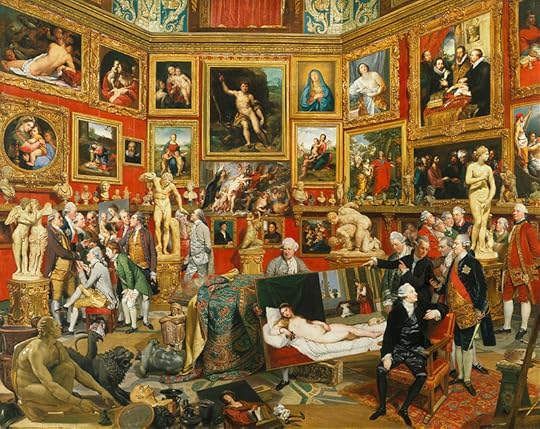
Detail from Tribuna of the Uffizi. On the right side, from left to right:Mr Gordon, Patch, Sir John Taylor Bt, Sir Horace Mann and in front, sitting, Felton Hervey (brother of John Hervey, 2nd Baron Hervey)
In 1775, on the death of his elder brother, Edward Louisa Mann, he inherited the Linton Park estate which his father had bought at Linton, Kent.
He died unmarried in Florence on 6 November 1786. His nephew Horace inherited his baronetcy by special remainder and also acted as Chargé d'affaires until the arrival of his replacement.
( Mann Genealogy )
https://www.google.com/maps/d/edit?mid=zdRJwtySDT14.k4ln0xmbkVNk&usp=sharing
 comments
comments
Linton
Maidstone, Kent ME17
Regno Unito
Linton Park, formerly Linton Place or Linton Hall, is a large 18th-century country house in Linton, Kent, England. Built by Robert Mann in 1730 to replace an earlier building, the house and estate passed through the ownership of several members of Mann's family before coming into the Cornwallis family. The house was enlarged to its current size in 1825.
The house sits in a prominent location, part way down a south-facing slope which provides excellent views of the grounds and the Weald beyond. Gardens close to the house contain formal walks laid out in 1825 with specimen trees planted then and later.

The house is a Grade I listed building and the garden and park is listed Grade II*. Other buildings and structures in the park are also listed.
Linton Park is now the corporate headquarters of Camellia plc, an international agricultural company.
Sir Horace (Horatio) Mann, 1st Baronet KB (c.25 August 1706 - 6 November 1786), diplomat, was a long standing British resident in Florence. He was the second son of Robert Mann (1678–1751), a successful London merchant, and his wife. He was brought up at Chelsea, and educated at Eton College and later, briefly, at Clare College, Cambridge.

He kept an open house for British visitors at Florence, inviting them for conversazione when there was no performance at the theatre. His generosity and kindness was universally acknowledged, although his close friendship with the painter Thomas Patch (expelled from Rome after a homosexual incident) and with the effete John, 2nd Earl Tylney, reflected on his reputation. He met Horace Walpole (to whom he was distantly related, Mann's great-great-grandmother was the sister of an ancestress of Walpole) in 1739, and conducted a now-renowned correspondence with him over forty years, though they last met in 1741. The correspondence was published by Lord Dover in 1833.
William, 2nd Earl Fitzwilliam wrote that: “Sir Horace is the most finical man in the world: if you speak a little loud, he can’t bear it, it hurts his nerves, he dies – and he vomits If you eat your petite pate before your soup: take him as he is, without least notice, he is perfect character for the stage. He has been so long out of England, that he had lost the manliness of an Englishman, and has borrowed the effeminacy of Italy. But with all his little airs, he is a good kind of man, and is very civil.”

Detail from Tribuna of the Uffizi. On the right side, from left to right:Mr Gordon, Patch, Sir John Taylor Bt, Sir Horace Mann and in front, sitting, Felton Hervey (brother of John Hervey, 2nd Baron Hervey)
In 1775, on the death of his elder brother, Edward Louisa Mann, he inherited the Linton Park estate which his father had bought at Linton, Kent.
He died unmarried in Florence on 6 November 1786. His nephew Horace inherited his baronetcy by special remainder and also acted as Chargé d'affaires until the arrival of his replacement.
( Mann Genealogy )
https://www.google.com/maps/d/edit?mid=zdRJwtySDT14.k4ln0xmbkVNk&usp=sharing
 comments
comments
Published on January 10, 2016 01:50
January 9, 2016
Queer Places: Steuben House
Address: Steuben House
1209 Main St,
River Edge,
NJ 07661,
USA
On December 23, 1783, the State of New Jersey presented Friedrich Wilhelm von Steuben with the use of an estate in Bergen County now known as Steuben House, which had been confiscated from Loyalist Jan Zabriskie in 1781. Located in the formerly strategic New Bridge Landing, the estate included a gristmill and about 40 acres of land. Legislators initially conditioned the grant, requiring Steuben to "hold, occupy and enjoy the said estate in person, and not by tenant". Gen. Philemon Dickinson of the New Jersey Militia informed the baron of this gift and responded to his inquiries that "there are on the premises an exceeding good House, an excellent barn, together with many useful outbuildings, all of which I am told, want some repairs...there is...a Grist-mill; a good Orchard, some meadow Ground, & plenty of Wood. The distance from N York by land 15 miles, but you may keep a boat & go from your own door to New York by water—Oysters, Fish & wild fowl in abundance—Possession will be given to you in the Spring, when you will take a view of the premises." Von Steuben spent considerable sums to repair wartime damages to the house and restore its commercial operations under former aide Walker.

On September 5, 1788, the New Jersey Legislature gave Baron von Steuben full title to the former Zabriskie estate. A month later, recognizing his financial embarrassment, Steuben wrote another former aide-de-camp and companion, William North, recognizing: "The jersey Estate must and is to be sold. Walker is my administrator, all debts are to be paid out of it." On November 6, 1788, Steuben again wrote North (at his new home in Duanesburg), noting "My jersey Estate is Advertised but not yet Sold, from this Walker Shall immediately pay to you the money, you so generously lend me and all my debts in New-York will be payed. I support my present poverty with more heroism than I Expected. All Clubs and parties are renounced, I seldom leave the House." Steuben eventually sold the New Jersey property to a son of the previous owner, and it remained in the Zabriskie family until 1909, so today it is the only remaining eighteenth-century building that von Steuben owned.
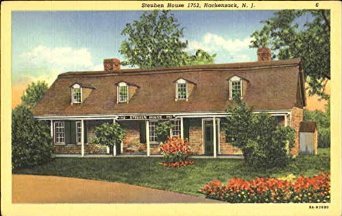
Von Steuben moved upstate and settled in Oneida County on a small estate in the vicinity of Rome, on land granted to him for his military service and where he had spent summers. He was later appointed a regent for what evolved into the University of the State of New York.
Von Steuben died on November 28, 1794, and was buried in a grove at what became the Steuben Memorial State Historic Site in a town named Steuben, New York. The Steuben Memorial State Historic Site is a historic location and state park in the eastern part of Steuben, Oneida County, New York, that honors Baron von Steuben, the "Drillmaster of the American Revolution." The land in this part of Oneida County was part of a 16,000-acre (6,500 ha) land grant made to von Steuben for his services to the United States. He used the land for his summer residence. He is buried at the memorial, a "Sacred Grove." The site includes the memorial tomb and reconstructed log cabin (1937) and several smaller elements including a memorial plaque bearing stone, a series of historic markers, and a landscaping structure. It was listed on the National Register of Historic Places in 2009.

The Steuben House Commission was created in 1926 to purchase Baron Steuben's home at New Bridge. The State took possession of the historic mansion and 1-acre (4,000 m2) of ground for $9,000 on June 27, 1928. It was renovated and opened as the museum headquarters of the Bergen County Historical Society in September 1939. The Steuben House is listed on the New Jersey and National Register of Historic Places. The Bergen County Historical Society continued stewardship of the site by purchase of land between the Steuben House and the encroaching autoparts yard in 1944. In 1954, the Society was able to persuade the County of Bergen to divert the planned 4-lane highway to the north of the site instead of alongside the historic site. The highway bridge opened in 1956 and the one-lane 1889 swing bridge was closed to vehicles. It remains open for pedestrians.
The house is now the cornerstone of this historic district, spanning both sides of the river. Three additional buildings were moved onto the adjacent property of the Bergen County Historical Society, a private non-profit volunteer organization. The Demarest House was moved here from New Milford in 1956 and is maintained by the Blauvelt Demarest Foundation. The Westervelt-Thomas Barn was relocated from Washington Township in 1958. The County of Bergen moved the Campbell-Christie House here to lands of the Bergen County Historical Society in 1977. The Society erected a working replica of a Bergen Dutch Out-Kitchen in 1991 and an outhouse in 2009.
The Historic New Bridge Landing Park Commission was established by law in 1995 to coordinate and implement all private and governmental plans and activities at Historic New Bridge Landing Park, which was named one of three new urban state parks in 2004.
Steuben legally adopted two handsome soldiers, William North (b. 1755, d. January 3, 1836, who later became a US senator) and Benjamin Walker (b. 1753, d. January 13, 1818). A third young man, John W. Mulligan Jr. (b. 1774, d. 1862), also considered himself one of Steuben’s “sons.” His birth father, John “Hercules” Mulligan, had been Alexander Hamilton’s roommate many years before.
( Friedrich Wilhelm von Steuben Life )
https://www.google.com/maps/d/edit?mid=zdRJwtySDT14.k4ln0xmbkVNk&usp=sharing
 comments
comments
1209 Main St,
River Edge,
NJ 07661,
USA
On December 23, 1783, the State of New Jersey presented Friedrich Wilhelm von Steuben with the use of an estate in Bergen County now known as Steuben House, which had been confiscated from Loyalist Jan Zabriskie in 1781. Located in the formerly strategic New Bridge Landing, the estate included a gristmill and about 40 acres of land. Legislators initially conditioned the grant, requiring Steuben to "hold, occupy and enjoy the said estate in person, and not by tenant". Gen. Philemon Dickinson of the New Jersey Militia informed the baron of this gift and responded to his inquiries that "there are on the premises an exceeding good House, an excellent barn, together with many useful outbuildings, all of which I am told, want some repairs...there is...a Grist-mill; a good Orchard, some meadow Ground, & plenty of Wood. The distance from N York by land 15 miles, but you may keep a boat & go from your own door to New York by water—Oysters, Fish & wild fowl in abundance—Possession will be given to you in the Spring, when you will take a view of the premises." Von Steuben spent considerable sums to repair wartime damages to the house and restore its commercial operations under former aide Walker.

On September 5, 1788, the New Jersey Legislature gave Baron von Steuben full title to the former Zabriskie estate. A month later, recognizing his financial embarrassment, Steuben wrote another former aide-de-camp and companion, William North, recognizing: "The jersey Estate must and is to be sold. Walker is my administrator, all debts are to be paid out of it." On November 6, 1788, Steuben again wrote North (at his new home in Duanesburg), noting "My jersey Estate is Advertised but not yet Sold, from this Walker Shall immediately pay to you the money, you so generously lend me and all my debts in New-York will be payed. I support my present poverty with more heroism than I Expected. All Clubs and parties are renounced, I seldom leave the House." Steuben eventually sold the New Jersey property to a son of the previous owner, and it remained in the Zabriskie family until 1909, so today it is the only remaining eighteenth-century building that von Steuben owned.

Von Steuben moved upstate and settled in Oneida County on a small estate in the vicinity of Rome, on land granted to him for his military service and where he had spent summers. He was later appointed a regent for what evolved into the University of the State of New York.
Von Steuben died on November 28, 1794, and was buried in a grove at what became the Steuben Memorial State Historic Site in a town named Steuben, New York. The Steuben Memorial State Historic Site is a historic location and state park in the eastern part of Steuben, Oneida County, New York, that honors Baron von Steuben, the "Drillmaster of the American Revolution." The land in this part of Oneida County was part of a 16,000-acre (6,500 ha) land grant made to von Steuben for his services to the United States. He used the land for his summer residence. He is buried at the memorial, a "Sacred Grove." The site includes the memorial tomb and reconstructed log cabin (1937) and several smaller elements including a memorial plaque bearing stone, a series of historic markers, and a landscaping structure. It was listed on the National Register of Historic Places in 2009.

The Steuben House Commission was created in 1926 to purchase Baron Steuben's home at New Bridge. The State took possession of the historic mansion and 1-acre (4,000 m2) of ground for $9,000 on June 27, 1928. It was renovated and opened as the museum headquarters of the Bergen County Historical Society in September 1939. The Steuben House is listed on the New Jersey and National Register of Historic Places. The Bergen County Historical Society continued stewardship of the site by purchase of land between the Steuben House and the encroaching autoparts yard in 1944. In 1954, the Society was able to persuade the County of Bergen to divert the planned 4-lane highway to the north of the site instead of alongside the historic site. The highway bridge opened in 1956 and the one-lane 1889 swing bridge was closed to vehicles. It remains open for pedestrians.
The house is now the cornerstone of this historic district, spanning both sides of the river. Three additional buildings were moved onto the adjacent property of the Bergen County Historical Society, a private non-profit volunteer organization. The Demarest House was moved here from New Milford in 1956 and is maintained by the Blauvelt Demarest Foundation. The Westervelt-Thomas Barn was relocated from Washington Township in 1958. The County of Bergen moved the Campbell-Christie House here to lands of the Bergen County Historical Society in 1977. The Society erected a working replica of a Bergen Dutch Out-Kitchen in 1991 and an outhouse in 2009.
The Historic New Bridge Landing Park Commission was established by law in 1995 to coordinate and implement all private and governmental plans and activities at Historic New Bridge Landing Park, which was named one of three new urban state parks in 2004.
Steuben legally adopted two handsome soldiers, William North (b. 1755, d. January 3, 1836, who later became a US senator) and Benjamin Walker (b. 1753, d. January 13, 1818). A third young man, John W. Mulligan Jr. (b. 1774, d. 1862), also considered himself one of Steuben’s “sons.” His birth father, John “Hercules” Mulligan, had been Alexander Hamilton’s roommate many years before.
( Friedrich Wilhelm von Steuben Life )
https://www.google.com/maps/d/edit?mid=zdRJwtySDT14.k4ln0xmbkVNk&usp=sharing
 comments
comments
Published on January 09, 2016 01:28
January 8, 2016
Queer Places: Church of St Mary, Charlcombe
Address: The Parish Church of Saint Mary the Virgin
Charlcombe
Bath and North East Somerset,
UK
In 1748 Sarah Scott (sister of Elizabeth Montagu, a British social reformer, patron of arts, salonist, literary critic, and writer who helped organize and lead the Bluestocking Circle) met Lady Barbara Montagu, with whom she maintained an intimate relationship until Lady Barbara’s death. They pooled their finances and took house together in Bath. In June 1751, Sarah Scott married George Lewis Scott, tutor to the Prince of Wales, but was an unhappy marriage. They remained together one year until she was “taken from her house and husband by her father and brothers” in mysterious circumstances. Lady Barbara Montagu, (“Lady Bab”), had accompanied the Scotts on honeymoon (a contemporary custom) and lived with them during their year together. After that, Lady Bab, who went to Bath because she was suffering from an incurable illness, set up home with Sarah Scott in a Bath suburb.

Lady Barbara died in August 1765. “Charlcombe is one mile and half northeast of Bath, and is a village of only nine houses and a church, small, but very ancient, and well worth an antiquary’s notice. The situation of this diminutive parish is under Lansdown: its views are not extensive, but very pretty. It is almost surrounded with hills adorned with woods and coppices. Visiting the church, our minds were forcibly struck on reading an inscription, pointing out the place of internment of the right honourable lady Barbara Montagu, daughter of George earl of Halifax. The idea of title, when connected with such a spot as this, would be an incongruity, did it not lead us to contemplate that equality to which all return, when we find those, whom birth and fortune buoy up above the common level of mankind, seeking their last repose in the obscurity of Charlcombe”. (An excerpt from A Picturesque Guide to Bath, Bristol Hot-Wells, the River Avon, and the Adjacent Country: Illustrated with a set of views, taken in the summer of 1792; by Mess. Ibbetson, Laporte and J. Hassell; and engraved in Aquatinta. London: Printed for Hookham and Carpenter, Bond-Street, 1793.)
Currently Charlcombe is a civil parish and small village just north of Bath in the Bath and North East Somerset unitary authority, Somerset, England. The parish has a population of 422 and includes the villages of Woolley and Langridge. The valley is currently the centre of attention for the Save Woolley Valley Campaign led by the SWVAG (chaired by Robert Craven).

1844 St Mary’s Charlcombe, Bath
The Anglican Church of St Mary in Charlcombe within the English county of Somerset was built in the 12th century. It is a Grade II* listed building. On the Chancel there is the monument to Lady Barbara Montagu, died 1765, by Ford of Bath, marble, a woman in robes rests on a plinth, aedicular surround with open pediment and arms.
It underwent Victorian restoration between 1857 and 1861. The work was probably carried out by James Wilson from plans drawn up by George Gilbert Scott. There is believed to be a holy well in the grounds. Charlcombe was formerly the mother church of Bath. In acknowledgment of this Bath Abbey sent a pound of pepper on an annual basis. On November 28, 1734, Henry Fielding got married to Charlotte Craddock in the church. Above the nave is a small bell turret. Inside the church is a font which is as old as the church itself. The parish is part of the benefice of Charlcombe with St Stephen's Church, Bath within the Diocese of Bath and Wells.
Around 1751, Sarah Fielding moved to Bath. Ralph Allen (b. 1693, d. 29 June 1764, was an entrepreneur and philanthropist, and was notable for his reforms to the British postal system.) probably lent her the Widcombe Cottage (Widcombe Lodge, Church St, Bath, Bath and North East Somerset BA2 6AZ, UK is still visible today and there is a plague to her above the gateway) and eventually left her an annual legacy.
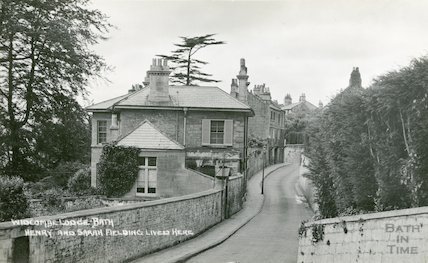
Henry Fielding's House, Widcombe Lodge, Bath, c.1920s
When Jane Collier died (summer 1755), Sarah Fielding coped with the loss of her loved ones (her brother Henry dead as well) by devoting herself to writing. Fielding is often seen as a reclusive figure, but Fielding was a significant influence in a community of like-minded women at Bath. These women included friends of the Duchess of Portland, who entertained many erudite women at her nearby home, “Bulstrode”. Among them were Elizabeth Elstob (1683-1756), “the Saxon Scholar”, who acted as governess to the Duchess’s children, Sarah Scott (née Robinson) (September 12, 1720 – November 3, 1795), Lady Barbara Montagu (sister to the second earl of Halifax, and no direct relation to Scott’s sister, Mrs Elizabeth Montagu), Elizabeth Cutts, Mrs Arnold, Mrs Adams, Margaret Riggs, Margaret Mary Rivaud, Miss Chudleigh, Mrs Anne Robinson Knight and possibly the poet, Esther Lewis.
Elizabeth Cutts was probably the sister of Mordecai Cutts Esq., of Thorne, Yorkshire. After the death of Lady Barbara Montagu, Cutts sometime was (as was Miss Arnold), Scott’s companion in an egalitarian sense. Miss Arnold is connected to a Mr Arnold of Wells, probably Christopher Arnold, Esq.
At some point in 1766, Sarah Fielding moved in with Sarah Scott near Walcot. In November 1767 Elizabeth Montagu wrote to Carter, “Poor Mrs. Fielding is declining very fast”. Fielding was living with Scott during the spring of 1768, when the Bath community of women opened an all-female establishment at a house in Hitcham owned by Elizabeth Montagu’s relative. Hitcham was a L-shaped early 17th century house with two stories, an attic, and a good garden (I suppose they refer to Hitcham Manor, 'Parishes: Hitcham', in A History of the County of Buckingham: Volume 3, ed. William Page (London, 1925), pp. 231-235 http://www.british-history.ac.uk/vch/... [accessed 2 January 2016]). Sarah Scott was joined by Elizabeth Cutts, Miss Arnold and Grace Freind. Montagu sent livestock and offered to pay Fielding’s travelling expenses to join them, but Scott’s letter to her sister reveals Fielding’s reticence to travel.
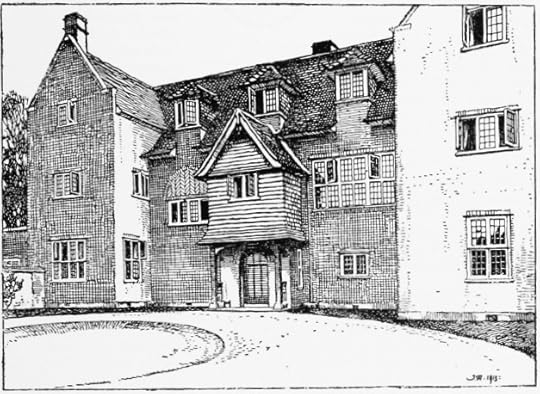
Sarah Fielding died at the age of 57 on April 9, 1768; she, like Lady Barbara Montagu, was buried on 14 April 1768 in St. Mary’s, Charlcombe, Bath, near the entrance to the chancel, close to the Rector's seat (Biography of Henry Fielding by Austin Dobson). Supposedly on a mural tablet, you should read “Esteemed and loved, near this place lies Mrs. Sarah Fielding. She died April 9, 1768, aged 60. How worthy of a nobler monument! But her name will be written in the Book of Life.” (Literary Anecdotes of the Eighteenth Century: Comprizing Biographical Memoirs of William Bowyer, Printer, F.S.A. and many of his learned friends; An incidental view of the progress and advancement of literature in this kingdom during the last century; and Biographical Anecdotes of a considerable number of Eminent Writers and Ingenious Artists. By John Nichols, F.S.A., Volume IX. London: Printed for the Author, by Nichols, Son, and Bentley, at Cicero’s Head, Red-Lion-Passage, Fleet-Street. 1815) But there is no grand memorial, no elaborate grave. Not even a simple marker to be seen.
There is a monument to her in the west porch of Bath Abbey, erected by her friend John Hoadly, poet and dramatist. “In this City lived and died Sarah, second daughter of General Henry Fielding; by his first wife, daughter of Judge Gould. Whose writings will be known, an incentives to virtue, and honour to her sex, when this marble shall be dust. She was born MDCCXIV, and died April MDCCLXVIII. Her unaffected manners, candid mind, her heart benevolent, and soul resign’d, were more her praise than all she knew or thought, though Athens’ wisdom to her sex she taught. The Rev. Dr. John Hoadly, her Friend, for the honour of the Dead and emulation of the Living, inscribes this deficient Memorial of her virtues and accomplishments.”
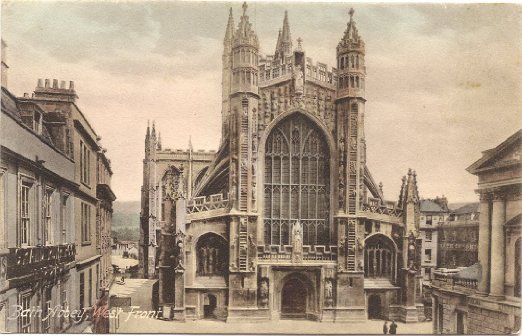
1910 Vintage Postcard - West Front - Bath Abbey - Bath England UK
The real life Hitcham “female utopia” was to fail by December 1768.
( Montagu Genealogy )
https://www.google.com/maps/d/edit?mid=zdRJwtySDT14.k4ln0xmbkVNk&usp=sharing
 comments
comments
Charlcombe
Bath and North East Somerset,
UK
In 1748 Sarah Scott (sister of Elizabeth Montagu, a British social reformer, patron of arts, salonist, literary critic, and writer who helped organize and lead the Bluestocking Circle) met Lady Barbara Montagu, with whom she maintained an intimate relationship until Lady Barbara’s death. They pooled their finances and took house together in Bath. In June 1751, Sarah Scott married George Lewis Scott, tutor to the Prince of Wales, but was an unhappy marriage. They remained together one year until she was “taken from her house and husband by her father and brothers” in mysterious circumstances. Lady Barbara Montagu, (“Lady Bab”), had accompanied the Scotts on honeymoon (a contemporary custom) and lived with them during their year together. After that, Lady Bab, who went to Bath because she was suffering from an incurable illness, set up home with Sarah Scott in a Bath suburb.

Lady Barbara died in August 1765. “Charlcombe is one mile and half northeast of Bath, and is a village of only nine houses and a church, small, but very ancient, and well worth an antiquary’s notice. The situation of this diminutive parish is under Lansdown: its views are not extensive, but very pretty. It is almost surrounded with hills adorned with woods and coppices. Visiting the church, our minds were forcibly struck on reading an inscription, pointing out the place of internment of the right honourable lady Barbara Montagu, daughter of George earl of Halifax. The idea of title, when connected with such a spot as this, would be an incongruity, did it not lead us to contemplate that equality to which all return, when we find those, whom birth and fortune buoy up above the common level of mankind, seeking their last repose in the obscurity of Charlcombe”. (An excerpt from A Picturesque Guide to Bath, Bristol Hot-Wells, the River Avon, and the Adjacent Country: Illustrated with a set of views, taken in the summer of 1792; by Mess. Ibbetson, Laporte and J. Hassell; and engraved in Aquatinta. London: Printed for Hookham and Carpenter, Bond-Street, 1793.)
Currently Charlcombe is a civil parish and small village just north of Bath in the Bath and North East Somerset unitary authority, Somerset, England. The parish has a population of 422 and includes the villages of Woolley and Langridge. The valley is currently the centre of attention for the Save Woolley Valley Campaign led by the SWVAG (chaired by Robert Craven).

1844 St Mary’s Charlcombe, Bath
The Anglican Church of St Mary in Charlcombe within the English county of Somerset was built in the 12th century. It is a Grade II* listed building. On the Chancel there is the monument to Lady Barbara Montagu, died 1765, by Ford of Bath, marble, a woman in robes rests on a plinth, aedicular surround with open pediment and arms.
It underwent Victorian restoration between 1857 and 1861. The work was probably carried out by James Wilson from plans drawn up by George Gilbert Scott. There is believed to be a holy well in the grounds. Charlcombe was formerly the mother church of Bath. In acknowledgment of this Bath Abbey sent a pound of pepper on an annual basis. On November 28, 1734, Henry Fielding got married to Charlotte Craddock in the church. Above the nave is a small bell turret. Inside the church is a font which is as old as the church itself. The parish is part of the benefice of Charlcombe with St Stephen's Church, Bath within the Diocese of Bath and Wells.
Around 1751, Sarah Fielding moved to Bath. Ralph Allen (b. 1693, d. 29 June 1764, was an entrepreneur and philanthropist, and was notable for his reforms to the British postal system.) probably lent her the Widcombe Cottage (Widcombe Lodge, Church St, Bath, Bath and North East Somerset BA2 6AZ, UK is still visible today and there is a plague to her above the gateway) and eventually left her an annual legacy.

Henry Fielding's House, Widcombe Lodge, Bath, c.1920s
When Jane Collier died (summer 1755), Sarah Fielding coped with the loss of her loved ones (her brother Henry dead as well) by devoting herself to writing. Fielding is often seen as a reclusive figure, but Fielding was a significant influence in a community of like-minded women at Bath. These women included friends of the Duchess of Portland, who entertained many erudite women at her nearby home, “Bulstrode”. Among them were Elizabeth Elstob (1683-1756), “the Saxon Scholar”, who acted as governess to the Duchess’s children, Sarah Scott (née Robinson) (September 12, 1720 – November 3, 1795), Lady Barbara Montagu (sister to the second earl of Halifax, and no direct relation to Scott’s sister, Mrs Elizabeth Montagu), Elizabeth Cutts, Mrs Arnold, Mrs Adams, Margaret Riggs, Margaret Mary Rivaud, Miss Chudleigh, Mrs Anne Robinson Knight and possibly the poet, Esther Lewis.
Elizabeth Cutts was probably the sister of Mordecai Cutts Esq., of Thorne, Yorkshire. After the death of Lady Barbara Montagu, Cutts sometime was (as was Miss Arnold), Scott’s companion in an egalitarian sense. Miss Arnold is connected to a Mr Arnold of Wells, probably Christopher Arnold, Esq.
At some point in 1766, Sarah Fielding moved in with Sarah Scott near Walcot. In November 1767 Elizabeth Montagu wrote to Carter, “Poor Mrs. Fielding is declining very fast”. Fielding was living with Scott during the spring of 1768, when the Bath community of women opened an all-female establishment at a house in Hitcham owned by Elizabeth Montagu’s relative. Hitcham was a L-shaped early 17th century house with two stories, an attic, and a good garden (I suppose they refer to Hitcham Manor, 'Parishes: Hitcham', in A History of the County of Buckingham: Volume 3, ed. William Page (London, 1925), pp. 231-235 http://www.british-history.ac.uk/vch/... [accessed 2 January 2016]). Sarah Scott was joined by Elizabeth Cutts, Miss Arnold and Grace Freind. Montagu sent livestock and offered to pay Fielding’s travelling expenses to join them, but Scott’s letter to her sister reveals Fielding’s reticence to travel.

Sarah Fielding died at the age of 57 on April 9, 1768; she, like Lady Barbara Montagu, was buried on 14 April 1768 in St. Mary’s, Charlcombe, Bath, near the entrance to the chancel, close to the Rector's seat (Biography of Henry Fielding by Austin Dobson). Supposedly on a mural tablet, you should read “Esteemed and loved, near this place lies Mrs. Sarah Fielding. She died April 9, 1768, aged 60. How worthy of a nobler monument! But her name will be written in the Book of Life.” (Literary Anecdotes of the Eighteenth Century: Comprizing Biographical Memoirs of William Bowyer, Printer, F.S.A. and many of his learned friends; An incidental view of the progress and advancement of literature in this kingdom during the last century; and Biographical Anecdotes of a considerable number of Eminent Writers and Ingenious Artists. By John Nichols, F.S.A., Volume IX. London: Printed for the Author, by Nichols, Son, and Bentley, at Cicero’s Head, Red-Lion-Passage, Fleet-Street. 1815) But there is no grand memorial, no elaborate grave. Not even a simple marker to be seen.
There is a monument to her in the west porch of Bath Abbey, erected by her friend John Hoadly, poet and dramatist. “In this City lived and died Sarah, second daughter of General Henry Fielding; by his first wife, daughter of Judge Gould. Whose writings will be known, an incentives to virtue, and honour to her sex, when this marble shall be dust. She was born MDCCXIV, and died April MDCCLXVIII. Her unaffected manners, candid mind, her heart benevolent, and soul resign’d, were more her praise than all she knew or thought, though Athens’ wisdom to her sex she taught. The Rev. Dr. John Hoadly, her Friend, for the honour of the Dead and emulation of the Living, inscribes this deficient Memorial of her virtues and accomplishments.”

1910 Vintage Postcard - West Front - Bath Abbey - Bath England UK
The real life Hitcham “female utopia” was to fail by December 1768.
( Montagu Genealogy )
https://www.google.com/maps/d/edit?mid=zdRJwtySDT14.k4ln0xmbkVNk&usp=sharing
 comments
comments
Published on January 08, 2016 13:15
Blog Tour: Lessons in Obedience by Tricia Owens
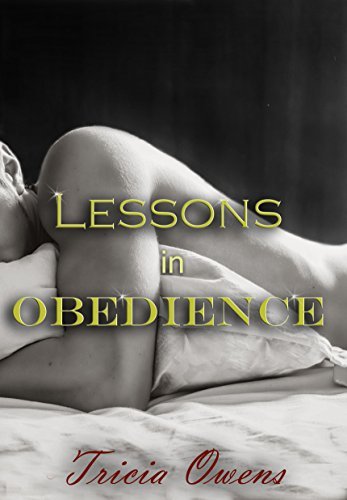 Lessons in Obedience, Death Defying Acts, The Doms Club (Sin City 6, 7, and 8) by Tricia Owens
Lessons in Obedience, Death Defying Acts, The Doms Club (Sin City 6, 7, and 8) by Tricia OwensBlurbs:
Lessons in Obedience
Publication Date: December 30, 2015
Amazon Kindle: Lessons in Obedience
Max and Ethan have survived the Las Vegas Mafia, foreign hitmen and obsessive stalkers, and their relationship is beginning to show the strain. To refresh their roles as Dominant and submissive, Max books them a vacation at a gay resort in Greece. Beneath the hot Mediterranean sun Ethan will know pain and he will know pleasure and he will learn what true surrender means when Max fully wields his power. Numerous graphic sexual situations. BDSM.
 Death Defying Acts
Death Defying ActsPublication Date: December 30, 2015
Amazon Kindle: Death Defying Acts
Business responsibilities and the Poole family legacy are distractions while Max and Ethan, bodyguards for the rich and spoiled of Las Vegas, take on an assignment protecting an aerial acrobatic duo who is being harassed by what seems to be a homophobic stalker. Max knows how important professionalism is. He owns the business. But the stress of the job and his own inability to resist the submissive siren call that is Ethan causes him to lose control. With a potentially dangerous, hateful stalker on the loose, can he afford to let down his guard and allow Ethan to get too close? Numerous graphic sexual situations. BDSM.
 The Doms Club
The Doms ClubPublication Date: January 2, 2016
Amazon Kindle: The Doms Club
Ethan has only a sketchy idea about his lover and boss' childhood, so when an old friend from Max's past arrives in Las Vegas, Ethan thinks it's his chance to learn more about the man he loves. What he hasn't counted on is this friend coming from a devious, highly sexual time during Max's life when the two men were members of the Doms Club. The Doms Club sought out potential submissives and tested their limits. Now, Max's friend wants to test Ethan's. Ethan badly wants to prove that he is the perfect submissive for Max, but maybe this time he's out of his league. Numerous graphic sexual situations. BDSM.
( Excerpt )

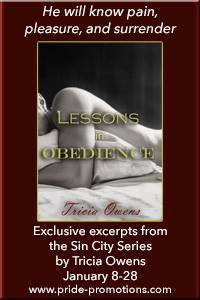 Meet the author: Tricia has been writing m/m and ménage fiction since 2002. An avid traveler who has visited over 70 countries, she writes full-time in Las Vegas.
Meet the author: Tricia has been writing m/m and ménage fiction since 2002. An avid traveler who has visited over 70 countries, she writes full-time in Las Vegas.Where to find the author:
Facebook Author Page: https://www.facebook.com/pages/Tricia...
Twitter: @JuxtaposeFantasy
Other: http://www.triciaowensbooks.com/list
Other: http://www.triciaowensbooks.com
Goodreads Link: https://www.goodreads.com/author/show...

( Tour Dates & Stops )
Giveaway:
Rafflecopter Prize: PDF copy of ‘Lessons in Obedience’
Rafflecopter Code:
a Rafflecopter giveaway

 comments
comments
Published on January 08, 2016 12:45
January 7, 2016
Queer Places: Strawberry Hill
Address: Strawberry Hill House
268 Waldegrave Rd,
Twickenham TW1 4ST,
UK
Strawberry Hill House — often called simply Strawberry Hill — is the Gothic Revival villa that was built in Twickenham, London by Horace Walpole from 1749. It is the type example of the "Strawberry Hill Gothic" style of architecture, and it prefigured the nineteenth-century Gothic revival.

Walpole rebuilt the existing house in stages starting in 1749, 1760, 1772 and 1776. These added gothic features such as towers and battlements outside and elaborate decoration inside to create "gloomth" to suit Walpole's collection of antiquarian objects, contrasting with the more cheerful or "riant" garden. The interior included a Robert Adam fireplace; parts of the exterior were designed by James Essex. The garden contained a large seat shaped like a Rococo sea shell; it has been recreated in the 2012 restoration.
After a £9 million, two-year-long restoration, Strawberry Hill House reopened to the public on Saturday 2 October 2010.
In 2013, Strawberry Hill House won the European Union Prize for Cultural Heritage in the Europa Nostra Awards. The Walpole Trust re-opened Strawberry Hill to the public on 1 March 2015.
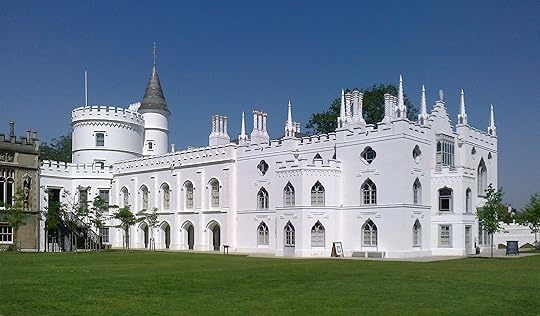
At 10 years old, Horace Walpole was sent to Eton College, where he became part of the “Quadruple Alliance” with Thomas Gray, Richard West and Thomas Ashton. Walpole and Gray remained friends throughout the latter’s life, and Walpole continued to champion his poetry and defend him personally in the many years he survived him. When Walpole decided to go travelling on the “Grand Tour” with Gray, he wrote a will whereby he left Gray all his belongings. In Europe the two had a bitter falling out that took years to put behind them. In later life, Walpole admitted that the fault lay primarily with himself: “to have been inattentive and insensible to the feelings of one I thought below me.”
Walpole left in his will his London villa, Strawberry Hill, to Anne Seymour Damer, Mary Berry and Mary’s sister, Agnes, to live there for all their life. A number of sources have named Damer as being involved in lesbian relationships, particularly relating to her close friendship with Mary Berry, to whom she had been introduced by Horace Walpole in 1789. Mary Berry was the last to survive, and at her death, the 6th earl of Waldegrave, as it was in Horace Walpole’s will, inherited Strawberry Hill, Twickenham (hence the name of Waldegrave Road, which connects Strawberry Hill with Teddington), but his son, George Edward, the 7th earl (1816–1846), was obliged in 1842 to sell the valuable treasures collected there. In 1923 the empty villa was bought by St Mary's University, Twickenham. In 2007, it was leased to the Strawberry Hill Trust for restoration and eventual opening to the public.
https://www.google.com/maps/d/edit?mid=zdRJwtySDT14.k4ln0xmbkVNk&usp=sharing
 comments
comments
268 Waldegrave Rd,
Twickenham TW1 4ST,
UK
Strawberry Hill House — often called simply Strawberry Hill — is the Gothic Revival villa that was built in Twickenham, London by Horace Walpole from 1749. It is the type example of the "Strawberry Hill Gothic" style of architecture, and it prefigured the nineteenth-century Gothic revival.

Walpole rebuilt the existing house in stages starting in 1749, 1760, 1772 and 1776. These added gothic features such as towers and battlements outside and elaborate decoration inside to create "gloomth" to suit Walpole's collection of antiquarian objects, contrasting with the more cheerful or "riant" garden. The interior included a Robert Adam fireplace; parts of the exterior were designed by James Essex. The garden contained a large seat shaped like a Rococo sea shell; it has been recreated in the 2012 restoration.
After a £9 million, two-year-long restoration, Strawberry Hill House reopened to the public on Saturday 2 October 2010.
In 2013, Strawberry Hill House won the European Union Prize for Cultural Heritage in the Europa Nostra Awards. The Walpole Trust re-opened Strawberry Hill to the public on 1 March 2015.

At 10 years old, Horace Walpole was sent to Eton College, where he became part of the “Quadruple Alliance” with Thomas Gray, Richard West and Thomas Ashton. Walpole and Gray remained friends throughout the latter’s life, and Walpole continued to champion his poetry and defend him personally in the many years he survived him. When Walpole decided to go travelling on the “Grand Tour” with Gray, he wrote a will whereby he left Gray all his belongings. In Europe the two had a bitter falling out that took years to put behind them. In later life, Walpole admitted that the fault lay primarily with himself: “to have been inattentive and insensible to the feelings of one I thought below me.”
Walpole left in his will his London villa, Strawberry Hill, to Anne Seymour Damer, Mary Berry and Mary’s sister, Agnes, to live there for all their life. A number of sources have named Damer as being involved in lesbian relationships, particularly relating to her close friendship with Mary Berry, to whom she had been introduced by Horace Walpole in 1789. Mary Berry was the last to survive, and at her death, the 6th earl of Waldegrave, as it was in Horace Walpole’s will, inherited Strawberry Hill, Twickenham (hence the name of Waldegrave Road, which connects Strawberry Hill with Teddington), but his son, George Edward, the 7th earl (1816–1846), was obliged in 1842 to sell the valuable treasures collected there. In 1923 the empty villa was bought by St Mary's University, Twickenham. In 2007, it was leased to the Strawberry Hill Trust for restoration and eventual opening to the public.
https://www.google.com/maps/d/edit?mid=zdRJwtySDT14.k4ln0xmbkVNk&usp=sharing
 comments
comments
Published on January 07, 2016 01:37
Blog Tour: Moment of Silence by Karen Stivali
 Moment of Silence (Series: Moments In Time 4) by Karen Stivali
Moment of Silence (Series: Moments In Time 4) by Karen StivaliPaperback: 230 pages
Publisher: Dreamspinner Press (December 18, 2015)
Language: English
ISBN-10: 1623808979
ISBN-13: 978-1623808976
Amazon: Moment of Silence (Series: Moments In Time 4)
Amazon Kindle: Moment of Silence (Series: Moments In Time 4)
Blurb: Growing up, Jason Stern led a charmed life complete with devoted sisters, a father who was one of Brooklyn’s most respected rabbis, and a mother who made the world's best babka. He headed to NYU ready for anything—except falling for the wrong guy, coming out, and getting disowned by his once-loving family. In spite of that, Jason managed to graduate with honors. He's got friends who treat him like family, and he's proudly running the largest LGBTQ teen shelter in Manhattan. Life is good, but he's still falling for the wrong men.
When charming, sexy Quinn Fitzpatrick begins work at the shelter, Jason falls hard and fast. Quinn is tall, blond, funny—damn near perfect. Only if Quinn’s gay, even he doesn't seem to know it. If he does, he's not telling anyone. And he's about one ceremony away from becoming a Catholic priest.
Long hours of work turn to long nights of talking and laughter, and Jason dares to hope this time he's falling for the right guy. But Quinn's got a past to deal with and major decisions to make about his future. When Quinn leaves for a silent retreat, Jason knows the silence may change everything.
( Excerpt )

 About the author: Karen Stivali is a prolific writer, compulsive baker and chocoholic with a penchant for books, movies, and fictional British men. She's also the multiple award-winning author of contemporary and erotic romances. She writes novels about love...like real life, only hotter.
About the author: Karen Stivali is a prolific writer, compulsive baker and chocoholic with a penchant for books, movies, and fictional British men. She's also the multiple award-winning author of contemporary and erotic romances. She writes novels about love...like real life, only hotter.Karen's lifelong fascination with people has led her to careers ranging from hand-drawn animator, to party planner, to marriage and family counselor, but writing has always been her passion. Karen enjoys nothing more than following her characters on their journey toward love. Whether the couples are m/f or m/m, it’s guaranteed that Karen's novels are filled with food, friendship, love, and smoking hot sex—all the best things in life.
When Karen isn’t writing (and often when she is), she can be found on Twitter attempting witty banter and detailing the antics of her fruit-loving cat, BadKitteh. She loves to hear from readers (and other writers), so don't hesitate to contact/follow/like her at: [insert contact info here]
1. What is the best gift you ever gave?
Quinn: An engagement ring.
Jason: *grins* That was an awesome gift.
Quinn: You’re an awesome gift.
Jason: I haven’t come up with something equivalent for you yet. I think the best gift I ever gave Campbell was letting him spend Christmas with his family without me around.
Quinn: Campbell loves you. So does his family.
Jason: I know. That’s why I wanted to do something special for them by giving them that family time, just for them.
Quinn: Like I said, you’re a gift. Just having you in someone’s life is all the gift that person needs.
2. What was your favorite subject in school?
Quinn: I actually enjoyed the religious studies. Bible stories are open to so many interpretations. I also liked shop. I love working with my hands.
Jason: You’re awesome with your hands.
Quinn: *flushes* I do my best.
Jason: I liked the psychology classes best. I love learning about how people think and what different things mean. People fascinate me and I want to understand whatever I can.
3. What is the last thing you tell your partner before bed?
Jason: We need to do laundry.
Quinn: *laughs* Which is usually quite true.
Jason: But then usually Quinn will say “Come here” and I’ll scoot closer.
Quinn: Then I’ll wrap my arms around you, even if I’m already half asleep.
Jason: And we’ll both say “I love you.” I’m not even sure I could sleep anymore without saying and hearing that every night.
Quinn: Me neither.
4. What is your motto?
Jason: Hope for the best, prepare for the worst.
Quinn: Never give up.
5. What is your biggest strength?
Quinn: I’m a good listener.
Jason: He is. He’s good at a lot of things though.
Quinn: So are you.
Jason: I don’t know what my biggest strength is. I guess persistence and determination. If I put my mind to something, I do it. No one can stop me once I set my mind to something.
Where to find the author:
Twitter: https://twitter.com/karenstivali
Facebook: https://www.facebook.com/karenstivali
Pinterest: http://www.pinterest.com/karenstivali/
Goodreads: https://www.goodreads.com/author/show...
Blog: http://karenstivali.com
Facebook Author Page: https://www.facebook.com/KarenStivali...
Goodreads Link: https://www.goodreads.com/author/show...

( Tour Dates & Stops )
Giveaway:
Prize: eBook copy of the Moments in Time series
Rafflecopter Code:
a Rafflecopter giveaway

 comments
comments
Published on January 07, 2016 01:11
January 6, 2016
Queer Places: Sanssouci Palace
Address:Sanssouci Palace
Maulbeerallee,
14469 Potsdam,
Germany
Sanssouci is the former summer palace of Frederick the Great, King of Prussia, in Potsdam, near Berlin. It is often counted among the German rivals of Versailles. While Sanssouci is in the more intimate Rococo style and is far smaller than its French Baroque counterpart, it too is notable for the numerous temples and follies in the park. The palace was designed/built by Georg Wenzeslaus von Knobelsdorff between 1745 and 1747 to fulfill King Frederick's need for a private residence where he could relax away from the pomp and ceremony of the Berlin court. The palace's name emphasises this; it is a French phrase (sans souci), which translates as "without concerns", meaning "without worries" or "carefree", symbolising that the palace was a place for relaxation rather than a seat of power.
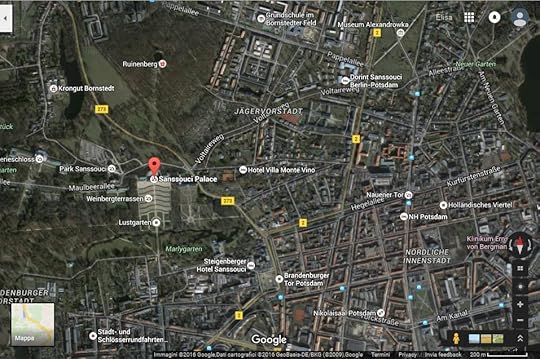
Sanssouci is little more than a large, single-story villa—more like the Château de Marly than Versailles. Containing just ten principal rooms, it was built on the brow of a terraced hill at the centre of the park. The influence of King Frederick's personal taste in the design and decoration of the palace was so great that its style is characterised as "Frederician Rococo", and his feelings for the palace were so strong that he conceived it as "a place that would die with him". Because of a disagreement about the site of the palace in the park, Knobelsdorff was fired in 1746. Jan Bouman, a Dutch architect, finished the project.
During the 19th century, the palace became a residence of Frederick William IV. He employed the architect Ludwig Persius to restore and enlarge the palace, while Ferdinand von Arnim was charged with improving the grounds and thus the view from the palace. The town of Potsdam, with its palaces, was a favourite place of residence for the German imperial family until the fall of the Hohenzollern dynasty in 1918.

After World War II, the palace became a tourist attraction in East Germany. Following German reunification in 1990, Frederick's body was returned to the palace and buried in a new tomb overlooking the gardens he had created. Sanssouci and its extensive gardens became a World Heritage Site in 1990 under the protection of UNESCO; in 1995, the Foundation for Prussian Palaces and Gardens in Berlin-Brandenburg was established to care for Sanssouci and the other former imperial palaces in and around Berlin. These palaces are now visited by more than two million people a year from all over the world.

Die Tafelrunde by Adolph von Menzel. The oval domed "Marble Hall" is the principal reception room of the palace. On the left side, in the purple coat, sits Voltaire; the other guests are Casanova, Marquis d'Argens, La Mettrie, the Keiths, Von Rothenburg, Von Stille and Francesco Algarotti.
Voltaire, long guest in the royal palace of Sans-Souci in Potsdam, left unequivocal evidence on Frederick II The Great’s homosexuality, arriving, in a letter of 1 December 1740, to define him “the respectable, unique and lovable bitch”.
On 15 June 1743 he wrote, addressing Frederick II as "Caesar":
I love Caesar in the embrace
Of his mistress that gives up to him;
I laugh and I'm not offended
to see him, young and handsome,
above and below in Nicomede.
I admire him more than Cato,
Since he is tender and magnanimous.
And in the same letter Voltaire wrote: "Your Majesty is with me a civettina [a coquette], very seductive".
Always him, talking about the Court of Potsdam with a female correspondent on 17 November 1750 specifies:
"I know, my dear child, all that is said about Potsdam around Europe. Especially women are wild (...) but this does not concern me (...). I well see, my dear child, that this country is not for you. I see that people spend ten months a year in Potsdam. This is not a Court, is a retreat from which the ladies are banned. And yet we are not in a monastery. Considering everything, wait for me in Paris ".

Voltaire and Frederick II of Prussia in Sanssouci (detail) - c. 1900
The meaning of the allusions by Voltaire is made clear by another witness, Giacomo Casanova (1725-1798), who wrote in his memoirs that he saw in Potsdam Frederick II drive the first battalion of his soldiers, all with a gold watch donated from him for having the courage to subdue him... like Caesar had made with Nicomedes. The thing, he assured, was no one mystery.
Casanova also tells, kindly amused, to have met in Wroclaw an Italian canon, Bastiani, who was a “Venetian abbot whom the King of Prussia had made the fortune. (...) He showed me all the sweet cards he had received from the King of Prussia before his promotion to the canon; this monarch was absolutely in love with Bastiani, and he wanted to become his woman, rewarding him, as a King".
https://www.google.com/maps/d/edit?mid=zdRJwtySDT14.k4ln0xmbkVNk&usp=sharing
 comments
comments
Maulbeerallee,
14469 Potsdam,
Germany
Sanssouci is the former summer palace of Frederick the Great, King of Prussia, in Potsdam, near Berlin. It is often counted among the German rivals of Versailles. While Sanssouci is in the more intimate Rococo style and is far smaller than its French Baroque counterpart, it too is notable for the numerous temples and follies in the park. The palace was designed/built by Georg Wenzeslaus von Knobelsdorff between 1745 and 1747 to fulfill King Frederick's need for a private residence where he could relax away from the pomp and ceremony of the Berlin court. The palace's name emphasises this; it is a French phrase (sans souci), which translates as "without concerns", meaning "without worries" or "carefree", symbolising that the palace was a place for relaxation rather than a seat of power.

Sanssouci is little more than a large, single-story villa—more like the Château de Marly than Versailles. Containing just ten principal rooms, it was built on the brow of a terraced hill at the centre of the park. The influence of King Frederick's personal taste in the design and decoration of the palace was so great that its style is characterised as "Frederician Rococo", and his feelings for the palace were so strong that he conceived it as "a place that would die with him". Because of a disagreement about the site of the palace in the park, Knobelsdorff was fired in 1746. Jan Bouman, a Dutch architect, finished the project.
During the 19th century, the palace became a residence of Frederick William IV. He employed the architect Ludwig Persius to restore and enlarge the palace, while Ferdinand von Arnim was charged with improving the grounds and thus the view from the palace. The town of Potsdam, with its palaces, was a favourite place of residence for the German imperial family until the fall of the Hohenzollern dynasty in 1918.

After World War II, the palace became a tourist attraction in East Germany. Following German reunification in 1990, Frederick's body was returned to the palace and buried in a new tomb overlooking the gardens he had created. Sanssouci and its extensive gardens became a World Heritage Site in 1990 under the protection of UNESCO; in 1995, the Foundation for Prussian Palaces and Gardens in Berlin-Brandenburg was established to care for Sanssouci and the other former imperial palaces in and around Berlin. These palaces are now visited by more than two million people a year from all over the world.

Die Tafelrunde by Adolph von Menzel. The oval domed "Marble Hall" is the principal reception room of the palace. On the left side, in the purple coat, sits Voltaire; the other guests are Casanova, Marquis d'Argens, La Mettrie, the Keiths, Von Rothenburg, Von Stille and Francesco Algarotti.
Voltaire, long guest in the royal palace of Sans-Souci in Potsdam, left unequivocal evidence on Frederick II The Great’s homosexuality, arriving, in a letter of 1 December 1740, to define him “the respectable, unique and lovable bitch”.
On 15 June 1743 he wrote, addressing Frederick II as "Caesar":
I love Caesar in the embrace
Of his mistress that gives up to him;
I laugh and I'm not offended
to see him, young and handsome,
above and below in Nicomede.
I admire him more than Cato,
Since he is tender and magnanimous.
And in the same letter Voltaire wrote: "Your Majesty is with me a civettina [a coquette], very seductive".
Always him, talking about the Court of Potsdam with a female correspondent on 17 November 1750 specifies:
"I know, my dear child, all that is said about Potsdam around Europe. Especially women are wild (...) but this does not concern me (...). I well see, my dear child, that this country is not for you. I see that people spend ten months a year in Potsdam. This is not a Court, is a retreat from which the ladies are banned. And yet we are not in a monastery. Considering everything, wait for me in Paris ".

Voltaire and Frederick II of Prussia in Sanssouci (detail) - c. 1900
The meaning of the allusions by Voltaire is made clear by another witness, Giacomo Casanova (1725-1798), who wrote in his memoirs that he saw in Potsdam Frederick II drive the first battalion of his soldiers, all with a gold watch donated from him for having the courage to subdue him... like Caesar had made with Nicomedes. The thing, he assured, was no one mystery.
Casanova also tells, kindly amused, to have met in Wroclaw an Italian canon, Bastiani, who was a “Venetian abbot whom the King of Prussia had made the fortune. (...) He showed me all the sweet cards he had received from the King of Prussia before his promotion to the canon; this monarch was absolutely in love with Bastiani, and he wanted to become his woman, rewarding him, as a King".
https://www.google.com/maps/d/edit?mid=zdRJwtySDT14.k4ln0xmbkVNk&usp=sharing
 comments
comments
Published on January 06, 2016 01:31



